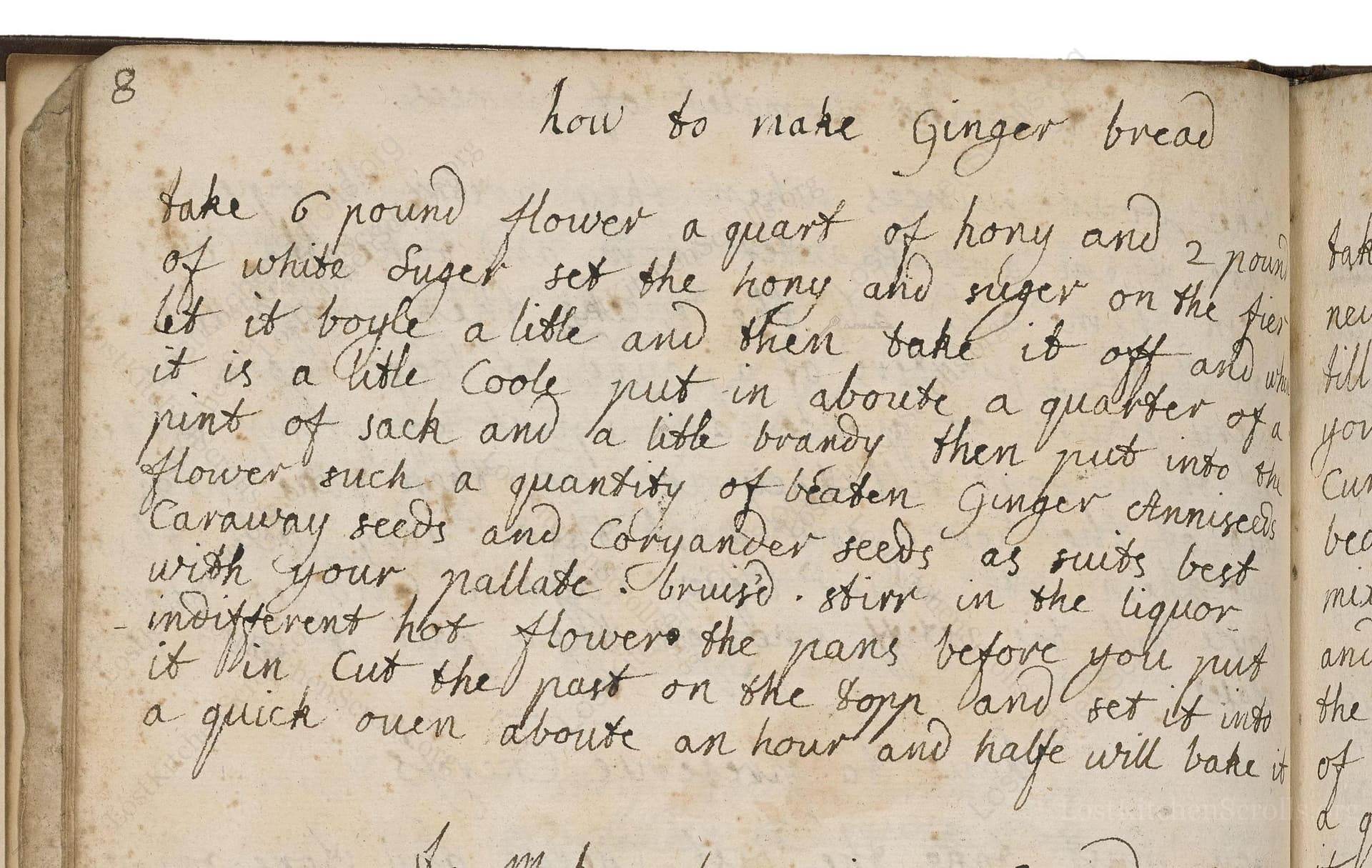How To Make Gingerbread
From the treasured pages of Receipt book
Unknown Author

How To Make Gingerbread
"Take 6 pound Flower a quart of hony and 2 pound of white suger set the hony and suger on the fier let it boyle a litle and then take it off and when it is a litle Coole put in aboute a quarter of a pint of sack and a litle brandy then put into the Flower such a quantity of beaten Ginger Anniseeds Caraway seeds and Coryander seeds as sutes best with your pallate brusid. stirr in the liquor indifferent hot flowere the pans before you put it in cut the past on the topp and set it in a quick oven an hour and halfe will bake it"
Note on the Original Text
The recipe employs seventeenth- and early eighteenth-century English spelling and punctuation—notice 'fier' for 'fire', 'boyle' for 'boil', and 'flowere' for 'flour'. Quantities are generous, suggesting large-scale household baking. Instructions are flexible ('as sutes best with your pallate'), inviting the baker's personal taste and experience. The recipe is written for someone already confident around the kitchen, with little explanation of method beyond the basics. Recording precise temperatures or pan sizes was uncommon; judgment and the senses ruled the day.

Title
Receipt book (1700)
You can also click the book image above to peruse the original tome
Writer
Unknown
Era
1700
Publisher
Unknown
Background
A delightful glimpse into the kitchens of the early 18th century, this historic culinary manuscript promises a feast of recipes, remedies, and perhaps a pinch of mystery. Expect both practical fare and elegant inspiration for the curious cook.
Kindly made available by
Folger Shakespeare Library
This gingerbread recipe hails from around 1700, a time when English gingerbread began to shift from a spice-laden preserve to a more recognizable cake. Wealthy households would often serve such treats at feasts and holidays. 'V.b.272' is the reference code for the original manuscript source, typical of recipe notebooks compiled by women in the English gentry. Sack and brandy show the celebratory and luxurious nature of baking in this period, as spices and spirits were symbols of hospitality and status.

The recipe would have been prepared with large earthenware or wooden bowls for mixing and a stout wooden spoon to stir the thick dough. Heavy iron or tin baking pans would be greased and dusted with flour. The cooking would have been done in a wood-fired oven, its heat judged by experience rather than by temperature gauge—a "quick oven" indicating a hot and lively fire.
Prep Time
30 mins
Cook Time
1 hr 30 mins
Servings
30
We've done our best to adapt this historical recipe for modern kitchens, but some details may still need refinement. We warmly welcome feedback from fellow cooks and culinary historians — your insights support the entire community!
Ingredients
- 6 lbs plain wheat flour
- 2 pints (4 cups) pure honey
- 2 lbs white granulated sugar
- 5 fl oz dry sherry (or medium sherry as substitute for 'sack')
- 1 fl oz brandy
- 2 tablespoons ground ginger (or more, to taste)
- 2 teaspoons crushed aniseed
- 2 teaspoons crushed caraway seeds
- 2 teaspoons crushed coriander seeds
- Butter and extra flour for greasing pans
Instructions
- Begin by weighing out 6 lbs of plain wheat flour.
- In a large saucepan, combine 2 pints (4 cups) of pure honey with 2 lbs of white granulated sugar.
- Warm the honey and sugar together, bringing it just to a gentle simmmer, then remove from the heat.
- Allow the mixture to cool slightly—just warm to the touch.
- Add about 5 fl oz of sherry (sack) and a small splash (about 1 fl oz) of brandy.
- In a separate bowl, prepare your flour by adding ground ginger (to taste, but 2 tablespoons is traditional), and 2 teaspoons each of roughly crushed aniseed, caraway seeds, and coriander seeds.
- These can be ajusted to suit your palate.
- Gradually mix the spiced flour into the warm honey-sugar-brandy mixture, stirring until well combined.
- Grease and flour your baking tins or trays, spread in the gingerbread mixture, make decorative cuts on the top, and bake in a preheated oven at 350°F (a 'quick oven') for about 1.5 hours, or until golden and set.
Estimated Calories
420 per serving
Cooking Estimates
Baking the gingerbread takes about 1.5 hours, and preparing the ingredients and mixing the dough takes about 30 minutes. This large batch can make around 30 generous servings. Each serving contains about 420 calories, mostly from honey, sugar, and flour.
As noted above, we have made our best effort to translate and adapt this historical recipe for modern kitchens, taking into account ingredients nowadays, cooking techniques, measurements, and so on. However, historical recipes often contain assumptions that require interpretation.
We'd love for anyone to help improve these adaptations. Community contributions are highly welcome. If you have suggestions, corrections, or cooking tips based on your experience with this recipe, please share them below.
Join the Discussion
Rate This Recipe
Dietary Preference
Main Ingredients

Den Bockfisch In Einer Fleisch Suppen Zu Kochen
This recipe hails from a German manuscript cookbook compiled in 1696, a time whe...

Die Grieß Nudlen Zumachen
This recipe comes from a rather mysterious manuscript cookbook, penned anonymous...

Ein Boudain
This recipe comes from an anonymous German-language manuscript cookbook from 169...

Ein Gesaltzen Citroni
This recipe, dating from 1696, comes from an extensive anonymous German cookbook...
Browse our complete collection of time-honored recipes



